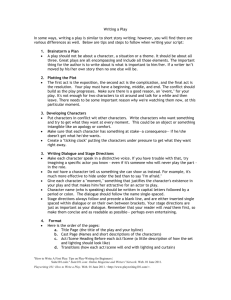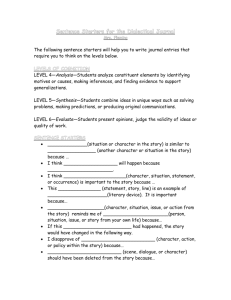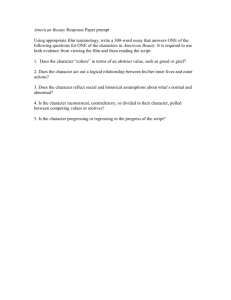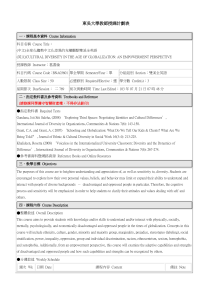What is a Synopsis - darrenarcher.name
advertisement
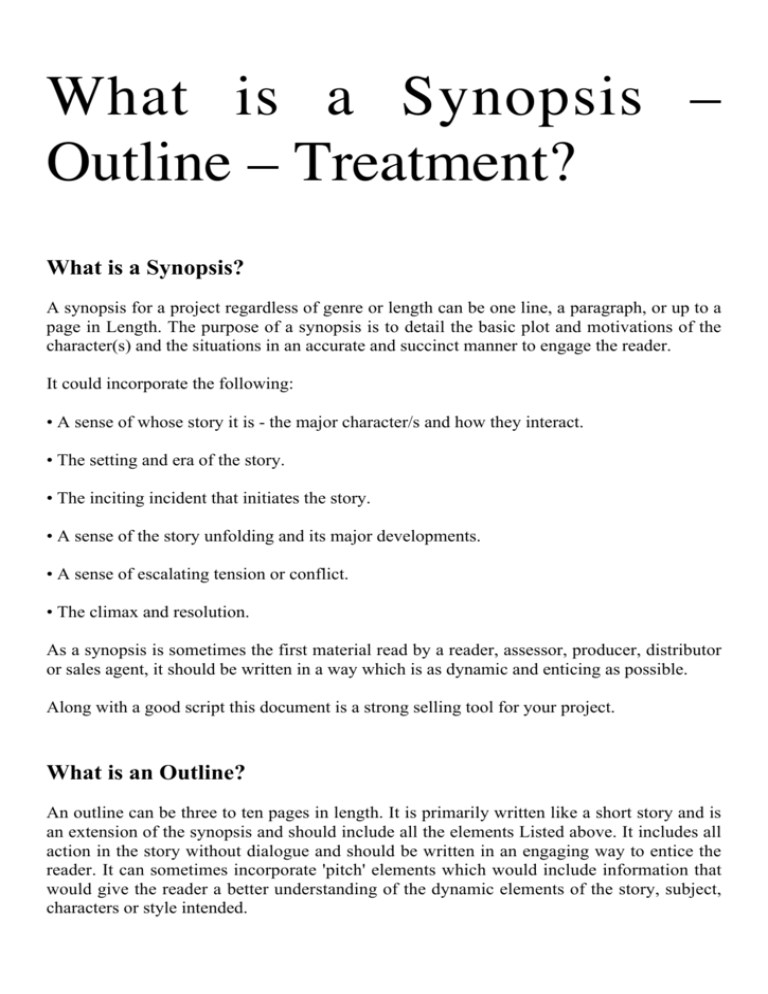
What is a Synopsis – Outline – Treatment? What is a Synopsis? A synopsis for a project regardless of genre or length can be one line, a paragraph, or up to a page in Length. The purpose of a synopsis is to detail the basic plot and motivations of the character(s) and the situations in an accurate and succinct manner to engage the reader. It could incorporate the following: • A sense of whose story it is - the major character/s and how they interact. • The setting and era of the story. • The inciting incident that initiates the story. • A sense of the story unfolding and its major developments. • A sense of escalating tension or conflict. • The climax and resolution. As a synopsis is sometimes the first material read by a reader, assessor, producer, distributor or sales agent, it should be written in a way which is as dynamic and enticing as possible. Along with a good script this document is a strong selling tool for your project. What is an Outline? An outline can be three to ten pages in length. It is primarily written like a short story and is an extension of the synopsis and should include all the elements Listed above. It includes all action in the story without dialogue and should be written in an engaging way to entice the reader. It can sometimes incorporate 'pitch' elements which would include information that would give the reader a better understanding of the dynamic elements of the story, subject, characters or style intended. What is a Scene Breakdown? A scene breakdown is a blueprint for a first draft screenplay or a useful toot for restructuring and rewriting. It should include all of the planned scenes for the film. Each scene is usually a paragraph with a scene header and contains a description of the principal action with little or no dialogue. Importantly, a scene breakdown should convey a sense of narrative momentum rather than dwelt on minor details. Examples of two scene breakdown 'scenes' follow: INT. NIGHTCLUB. NIGHT CLUBBERS dance to a heavy dance beat. MARK and SHARON enter the club and head for the dancefloor, looking fantastic with their new make-overs. JOANNE intercepts and tells them to come over to the bar to meet her new BOYFRIEND. INT. BAR. NIGHT At the bar MARK and SHARON are impressed. JAKE is their favourite DJ. JOANNE is proud and tells SHARON they are going away to London for the opening of JAKE'S new club. What is a Treatment (Drama)? A treatment for a project, regardless of genre or length of film, plots the narrative as it will appear on the screen. It is written in a straightforward prose style, normally in the present tense, and with little or no dialogue. White treatments usually concentrate on the plot, they can also incorporate ideas or feelings which inform the situations or characters. This can help the reader understand the motivations of the writer(s) and their intentions for the development of the project. The layout of a treatment should be written in short paragraphs. Each paragraph is a separate scene or sequence of events which advances the action of the story and characters. Following is a basic example of two paragraphs of treatment action: TOMMY DYSON (25), rough though handsome, drives his truck along the highway Listening to country and western music. He looks down at his pretty girlfriend SUE (22) who is asleep next to him. Up ahead a roadblock comes into view with police cars and ambulances. TOMMY slows the truck. The brakes skid, SUE wakes up. As they wait for the road to clear TOMMY uses the opportunity to ask SUE to move in with him. It is six months later. TOMMY and SUE chat about SUE'S new job at the newspaper office as they eat dinner in their kitchen . TOMMY tells SUE he thinks it is great that she has found something she toves doing. SUE watches him in admiration as he speaks. She wishes that he had a job he was happy with as well. She realises her love for him is growing stronger. These scenes would then be extended into the first draft of the script which advances the narrative through the use of dialogue and situations. All thoughts and feelings would be removed and incorporated through action and dialogue. The length of a treatment varies. For a short feature it could be 10-20 pages; for a feature film 15-30 pages or more depending on the subject and writing style. What is a Treatment (Documentary)? A documentary treatment should tell the story of the program as it happens making it clear what the audience is watching and hearing. It should not be a history, nor should it contain excessive background information about the subject or characters. This information should be included as separate material, Often, the most interesting and successful treatments for documentaries infer the style which is intended. This gives the reader a clear idea of the filmmaker's approach to their material. As documentaries are realised in many visual and aural forms and incorporate other elements which differ from most drama eg archival film, photographs, interviews, artwork, graphics etc these should be included in the explanatory paragraphs. Following is a basic example of two paragraphs for a documentary treatment: RUTH RIDLEY is the strong and feisty daughter of the Preacher John Ridley. She sits in the studio before a beautiful, stylised naturescape of a sea at sunset. She explains the influence her father had on Arthur Stace who was Later to become known as Mr Eternity. A photo of John Ridley appears. It was John Ridley's sermon 'Echoes of Eternity' which supposedly converted Stace to Christianity in the 1930s. It was after this sermon that Stace took a piece of chalk from his pocket and wrote in beautiful copperplate script, the one word - Eternity on the sidewalks of Sydney which would influence many for the next four decades. The image of Arthur Stace appears, recreated, as he walks away from the Sydney Harbour Bridge wearing a dark coat and depression era hat. 1920s Archival footage of two male swimmers seen from overhead Lay on a cliff face. The turbulent sea hits the cliff as the sea runs over their bodies. John Ridley's poetic sermon booms Loudly as the sea returns to hit the cliff face as the swimmers hold on tightly. The length of a documentary treatment varies from project to project. A treatment of 5-15 pages should provide a clear understanding of the content or subject(s) which includes a strong sense of how the story is to unfold and any other elements at the discretion of the filmmaker. A detailed treatment of 15-30 pages would include a stronger sense of the documentary structure, possible sample interviewee dialogue and a more detailed exploration of the intended style. This is a well-researched document and for an experienced filmmaker could be used as the core document to proceed into production. A detailed documentary script of 45-50 pages for a 50-minute documentary would include detailed scenes including sample dialogue sequences and a strong sense of stylistic approach. AIL archival elements would be well researched and any re-enactments would be fully scripted. The best documentary scripts are written in a similar Layout style to drama scripts. This provides for a clear understanding of the majority of elements to be incorporated in the film. This would be the core document for proceeding into production. Exhaustive Lists of archival materials or additional dialogue should be kept as a separate accompanying document as sometimes this unnecessarily lengthens the script and makes for a Less than interesting read. Of course some documentaries follow events as they unfold so it is impossible to write a treatment that will accurately foretell what will happen in the film. In this case the most usual thing is to write about the intentions of the filmmaker. What are the issues that you want to address in the film? How will they be illustrated by following these characters or events? What do you hope you will be able to film? How will the style of the film help to illustrate and expand on the issues? What is essentially engaging about the characters? What is essentially compelling about the issues and events? How do you propose to construct a satisfying narrative structure? Following is a basic example of two paragraphs for a documentary treatment: RUTH RIDLEY is the strong and feisty daughter of the Preacher John Ridley. She sits in the studio before a beautiful, stylised naturescape of a sea at sunset. She explains the influence her father had on Arthur Stace who was Later to become known as Mr Eternity. A photo of John Ridley appears. It was John Ridley's sermon 'Echoes of Eternity' which supposedly converted Stace to Christianity in the 1930s. It was after this sermon that Stace took a piece of chalk from his pocket and wrote in beautiful copperplate script, the one word - Eternity on the sidewalks of Sydney which would influence many for the next four decades. The image of Arthur Stace appears, recreated, as he walks away from the Sydney Harbour Bridge wearing a dark coat and depression era hat. 1920s Archival footage of two male swimmers seen from overhead Lay on a cliff face. The turbulent sea hits the cliff as the sea runs over their bodies. John Ridley's poetic sermon booms Loudly as the sea returns to hit the cliff face as the swimmers hold on tightly. The length of a documentary treatment varies from project to project. A treatment of 5-15 pages should provide a clear understanding of the content or subject(s) which includes a strong sense of how the story is to unfold and any other elements at the discretion of the filmmaker. A detailed treatment of 15-30 pages would include a stronger sense of the documentary structure, possible sample interviewee dialogue and a more detailed exploration of the intended style. This is a well-researched document and for an experienced filmmaker could be used as the core document to proceed into production. A detailed documentary script of 45-50 pages for a 50-minute documentary would include detailed scenes including sample dialogue sequences and a strong sense of stylistic approach. AIL archival elements would be well researched and any re-enactments would be fully scripted. The best documentary scripts are written in a similar Layout style to drama scripts. This provides for a clear understanding of the majority of elements to be incorporated in the film. This would be the core document for proceeding into production. Exhaustive Lists of archival materials or additional dialogue should be kept as a separate accompanying document as sometimes this unnecessarily lengthens the script and makes for a Less than interesting read. Of course some documentaries follow events as they unfold so it is impossible to write a treatment that will accurately foretell what will happen in the film. In this case the most usual thing is to write about the intentions of the filmmaker. What are the issues that you want to address in the film? How will they be illustrated by following these characters or events? What do you hope you will be able to film? How will the style of the film help to illustrate and expand on the issues? What is essentially engaging about the characters? What is essentially compelling about the issues and events? How do you propose to construct a satisfying narrative structure? THE CONTENTS OF THIS DOCUMENT ARE PRIVATE AND CONFIDENTIAL SUGGESTED SCRIPT LAYOUT (Previously "Other Title") by DORA SMITH Based on a book by JEAN BROWN (If you have developed the project with the assistance of a government funding body you should indicate this here) FIFTH DRAFT FEBRUARY 2003 @ DORA SMITH, JUNE 2000 150 William Street, Epping NSW 2131, Australia Ph: (61 2) 9553 3344 1. INT. OFFICE. DAY 1 The cover page should include the script title, the number of the draft, the copyright symbol, a date and your name and contact details. All pages should be numbered in the top right hand corner. Use standard margins (2.Scm) at the top, bottom and right. A larger left margin is desirable, particularly for bigger scripts which may be bound on the side. Use a 3.9cm margin on the left hand side. FONT - Courier 12 point. 2. INT. OFFICE. NIGHT 2 SCENE HEADINGS: should be numbered, in bold and uppercase. The scene number should be on the left, the location should be indented about 1.5cm and the time of day 0.5cm after that - a tab between each will do. BODY TEXT (script description and action): should be left aligned. When a CHARACTER first appears in a script, the character name should be in uppercase. Thereafter (except when heading dialogue) it should always be in lowercase. DIALOGUE: should be indented 3.4cm from the left and the right. The character's name above the dialogue should be in uppercase and indented 5.4cm from the left. DORA The dialogue is indented 3.4cm from the left hand side of the page as well as the right hand side. DICK What happens when you need to put directions in dialogue? DORA Read on to find out. 3. INT. DINING ROOM. MORNING MORE ON DIALOGUE: If the dialogue is voice over (V/0) or the character speaking is off screen (O/S), this information is put next to the character's name. 3 DORA (O/S) But there's more .... If you wish to use parenthetical directions to indicate how dialogue is to be spoken, you can do so in a separate paragraph, in lowercase and in brackets, indented 4.4cm from the left, between the character name and the dialogue. DORA (sweetly) You are such a pain, Dick. If a direction is minimal, it may be included in the dialogue, in uppercase and in brackets. DICK Where’d you go? ... (CALLING) Dora, come back. I'm not finished. If a longer direction is needed within a speech, it must go in an action paragraph and the dialogue which follows must have the character name and 'CONT'D' before the line. DICK Dora? He walks towards the toilet door. DICK (CONT'D) Are you in here? I've got more questions. 4. INT/EXT DINING ROOM. DUSK 4 Dora enters through another door, and coming up behind Dick drags him back outside. When a scene starts at an interior location but moves to an exterior location, put INT/EXT in the scene heading as above (or EXT/INT if the scene starts outside and moves inside). If the audience doesn't need to see the movement through the door, the interior action would be one scene, and the exterior location would be a new scene. Alternatively you could invest in a script program for your computer. There are many of these available and some have become industry standard. Details are available via the website for the Australian Writers' Guild at www.awg.com.au
